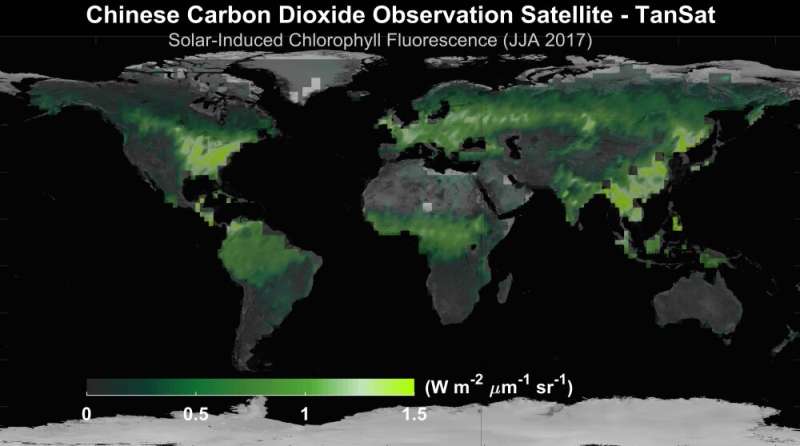The first TanSat global SIF map. Credit: TanSat
Solar-induced chlorophyll fluorescence (SIF) is emitted during plant photosynthesis. It is closely related to the terrestrial gross primary productivity (GPP), which calculates the total amount of carbon dioxide fixed through photosynthesis in a given area, and thus is necessary for global carbon sink research and carbon mitigation strategies.
The large natural carbon sink provided by plants can expand the capacity of the terrestrial ecosystem toward a carbon neutral future. Therefore, scientists must assess the natural carbon sink accurately to evaluate current and forthcoming carbon neutrality implementation plans.
Supported by the Ministry of Science and Technology of China, the Chinese Academy of Sciences, and the China Meteorological Administration, the Chinese Carbon Dioxide Monitoring Satellite Mission (TanSat) was launched in December 2016. TanSat monitors global atmospheric CO2 concentrations and is capable of measuring SIF.
The first TanSat global SIF map was constructed using a data-driven method based on the singular value decomposition (SVD) technique. TanSat now retrieves its SIF product from a new physical-based algorithm named IAPCAS/SIF. This algorithm is based on the CAS Institute of Atmospheric Physics Carbon Dioxide Retrieval Algorithm for Satellite Remote Sensing Platform.
Due to spatial scale differences, it is difficult to directly verify the accuracy and precision of satellite-measured SIF with SIF measured at the leaf or canopy scale. SIF retrievals still need more comprehensive verification trials that assess precision for further carbon flux estimations.
"The intercomparison between SIF products by different algorithms can verify the reliability of the algorithms, and also provide ideas for subsequent algorithm optimization," said Dr. Yang Dongxu, the principal investigator of TanSat mission.
YANG's team compared the TanSat SIF products provided by the new IAPCAS/SIF algorithm and the data-driven (SVD) method. Considering both scale and time, the results indicated that the two SIF products agreed well on a global extent throughout the year.
While the team noticed a slight regional bias in the SIF maps, the linear correlations between the two SIF products were strong, higher than 0.73, for all seasons. Their TanSat SIF algorithm comparison was published in Advances in Atmospheric Sciences.
Optimization of the IAPCAS/SIF algorithm will help to develop SIF products, and scientists hope that exploring the comprehensive usage of SIF products will promote the quantitive research of the global carbon sink and climate change.
TanSat SIF products are available from the Cooperation on the Analysis of carbon SAtellites data (CASA) TanSat data and science service.
More information: Lu Yao et al. A New Global Solar-induced Chlorophyll Fluorescence (SIF) Data Product from TanSat Measurements, Advances in Atmospheric Sciences (2021). DOI: 10.1007/s00376-020-0204-6
Provided by Chinese Academy of Sciences
























